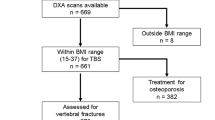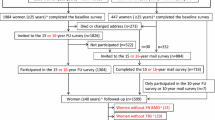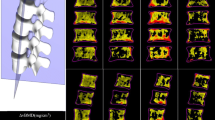Abstract
For several different bone mineral measurements and various skeletal sites, we compared capability to discriminate between women in various age decades with and without spinal fracture, and attempted to identify the most effective cutoff level in discrimination of spinal fracture. The subjects were 88 women aged 50–59 years (including 32 with fracture), 95 women aged 60–69 years (including 54 with fracture), and 34 women aged 70–79 years (including 18 with fracture). Spinal trabecular and cortical bone mineral density (BMD) were measured using quantitative computed tomography (CT), and spinal, radial (ultra-distal, 10% distal and 33% distal), and calcaneal BMD were measured by dual X-ray absorptiometry. These BMD values were obtained in each subject on the same day. Three statistical techniques—Student’s t-test, the logistic regression analysis, and the receiver operating characteristics (ROC) analysis—were applied and accuracy was calculated using the various cutoff values. The capability to discriminate between women with and those without fracture using these BMD values was different among the three age groups. In women aged 50–59 and 60–69 years, all measurements showed good capabilities for discriminating women with fracture. In women aged 70–79 years, these measurements showed lower capability than in those aged 50–59 and 60–69 years, but among them, the calcaneal and ultradistal radial BMD showed relatively good capability. The 10% and 33% distal radial BMD values were not useful in the detection of the high risk women with fracture. The cutoff BMD values for discrimination of women with fracture varied according to the sites and methods of measurement. For each specific age group, the most suitable measurement methods and the appropriate skeletal sites should be considered, and the effective cutoff values to discriminate those with fracture may differ according to the measurement methods, the skeletal sites examined, and age.
Similar content being viewed by others
References
Genant HK (1991) Measurement of bone mineral density: current status. Am J Med 91:5B 49–53S
Seeley DG, Browner WS, Nevitt MC, Genant HK, Scott JC, Cummings SR for the Study of Osteoporotic Fracture Research Group (1991) Which fractures are associated with low appendicular bone mass in elderly women? Ann Intern Med 115:837–884
Melton LJ III, Chao EYS, Lane J (1988) Biomechanical aspects of fracture. In: Riggs BL, Melton LJ III (eds) Osteoporosis: etiology, diagnosis and management. Raven Press, New York, pp 111–131
Ross PD, Davis JW, Vogal JM, Wasnich RD (1990) A critical review of bone mass and the risk of fractures in osteoporosis. Calcif Tissue Int 46:149–161
Cummings SR, Block DM, Nevitt MC, Brownor W, Cauley J, Ensrud K, Genant HK, Palermo L, Scott J, Vogt TM (1993) Bone density at various sites for prediction of hip fracture. Lancet 341:72–75
Melton LJ III, Chrischilles EA, Cooper C, Lane AW, Riggs BL (1992) How many women have osteoporosis? J Bone Miner Res 7:1005–1010
Kanis JA, Melton LJ III, Christiansen C, Johnston CC, Khaltaev N (1994) The diagnosis of osteoporosis. J Bone Miner Res 9:1137–1141
Melton LJ III, Kan SH, Frye MA, Wahner HW, O’Fallon WM, Riggs BL (1989) Epidemiology of vertebral fractures in women. Am J Epidemiol 129:1000–1011
Matkovic V, Jelic T, Wardlaw GM, Ilich JZ, Goel PK, Wright JK, Andon MB, Smith KT, Heaney RP (1994) Timing of peak bone mass in Caucasian females and its implication for the prevention of osteoporosis. Inference from a cross-sectional model. J Clin Invest 93:799–808
Ito M, Hayashi K, Kawahara Y, Uetani M, Imaizumi Y (1993) The relationship of trabecular and cortical bone mineral density to spinal fractures. Invest Radiol 28:573–580
Kalender WA, Klotz E, Suess C (1987) Vertebral bone mineral analysis: an integrated approach with CT. Radiology 164: 419–423
Yamada M, Ito M, Hayashi K, Nakamura T (1993) Evaluation of calcaneal bone density by dual-energy x-ray absorptiometry (DXA): normal volunteer and cadaver studies. Am J Roent 16:621–627
Genant HK, Wu CY, vanKuijk C, Nevitt M (1994) Vertebral fracture assessment using a semi-quantitative technique. J Bone Miner Res 8:1137–1148
Metz CE (1989) Some practical issues of experimental design and data analysis in radiological ROC studies. Invest Radiol 24:234–245
Pacifici R, Rupich R, Griffin M, Chines A, Susman N, Avioli LV (1987) Dual energy radiography versus quantitative computer tomography for the diagnosis of osteoporosis. J Clin Endocrinol Metab 64:209–214
Jergas MJ, Breitenseher M, Glueer CC, Yu W, Genant HK (1995) Estimates of volumetric bone density from projectional measurements improve the discriminatory capability of dual x-ray absorptiometry. J Bone Miner Res 10:1101–1110
Ito M, Hayashi K, Yamada M, Uetani M, Nakamura T (1993) The influence of osteophytes on spinal bone mineral density and its relationship with fractures. Radiology 189:497–502
Cheng S, Suominen H, Era P, Heikkinen E (1994) Bone density of the calcaneus and fractures in 75- and 80-year old men and women. Osteoporosis Int 4:48–54
Author information
Authors and Affiliations
Rights and permissions
About this article
Cite this article
Ito, M., Hayashi, K., Ishida, Y. et al. Discrimination of spinal fracture with various bone mineral measurements. Calcif Tissue Int 60, 11–15 (1997). https://doi.org/10.1007/s002239900178
Received:
Accepted:
Issue Date:
DOI: https://doi.org/10.1007/s002239900178




